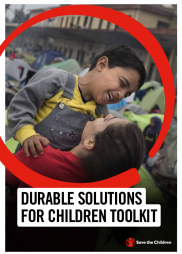« back to newsletter
October 2021
Laurent Grosbois, Senior Programme Advisor/Migration & Displacement Initiative, Save the Children

At the end of 2020, UNHCR estimated that of the 82.4 million forcibly displaced people, 35 million (42%) were children below 18 years of age, and that one million children were born as refugees between 2018 and 2020.
Despite global initiatives such as the Global Compact on Refugees and the UN High Level Panel on Internal Displacement, multiple challenges remain to solve forced displacement considering that only 6 million displaced individuals accessed durable solutions by the end of 2019. The international response still lacks capacity to address both the increase in humanitarian needs and the lack of durable solutions.
Age-specific vulnerabilities can compound the already considerable risks faced by children involved in displacement and unsafe migration. Therefore, Save the Children considers that children who have been displaced present distinctive vulnerabilities in terms of their physical and psychosocial well-being, and that they should enjoy, among other factors and without discrimination, access to safety, adequate standards of living, livelihood, housing, documentation and access to justice as part of any durable solution and sustainable reintegration.
Tackling together the most urgent needs and the underlying challenges to achieve durable solutions is a development issue with a humanitarian component. It is therefore essential to ensure complementarities and synergies between humanitarian, development, and peace-building programming. In this context, Save the Children has developed a child-specific toolkit including a set of indicators to complement existing durable solutions frameworks such as the Inter Agency Standing Committee (IASC) framework on durable solutions, which will allow practitioners to build evidence-based, child-focused long-term solutions and advocacy interventions. This toolkit provides substantial guidance on solutions including re-integration, action, and legal guidance. It can support to measure child-specific gaps in displacement and irregular migration settings, shape policy and decision-making, monitor improvements and increase the accountability of service providers.
By applying this framework, Save the Children is leading multiple initiatives, which include the development of programmes, innovation and research to ensure the integration of durable solutions outcomes into its actions. Between 2018 – 2019, a field study was conducted to ascertain the situation faced by children returned to four contexts (Syria, Iraq, Somalia and Afghanistan), to which the findings have shown that insufficient attention has been paid to the needs of children and substantial information about them is still lacking to better inform sustainable durable solutions. Moreover, child-focused approaches to achieving durable solutions will also be embedded in the Swiss-funded, multi-year, multi-country East Africa Migration Routes project.
Achieving durable solutions for children is a gradual, complex and often long-term process that involves addressing together the human rights, humanitarian, development, reconstruction and peace-building challenges. As such, it requires coordinated and timely engagement by a wide range of stakeholders from the outset. Save the Children has established partnerships with coordination forums such as the Regional Durable Solutions Secretariat (ReDSS) or with lead agencies in the field of migration and displacement, which has resulted recently in active collaboration with the International Organization for Migration in the development of specific tools such as a Monitoring Toolkit for the Sustainable Reintegration of Child Returnees.
Further information:
https://resourcecentre.savethechildren.net/library/durable-solutions-children-toolkit
https://resourcecentre.savethechildren.net/library/achieving-durable-solutions-returnee-children-what-do-we-know
